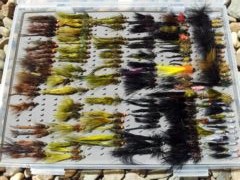Posts Tagged ‘Loch style wet flies’
{{start}}
Loch Style fly-fishing involves fly-fishing from a boat, side onto the wind, using a system incorporating one or a number of flies. There are both wet and dry lock style fishing techniques. There are four distinct sub sections of loch flies: wake or bob flies, dropper flies that can be placed in various position s in a team of flies for different effects, attractor flies which are generally fished on a middle dropper and point flies.
The dry fly technique involves casting out in the direction of the drift, stopping the cast above the water so as to let the team of flies settle, waiting the desired time (often only 5 to 10 seconds) and then repeating the process in a slightly different position. Dry fly Loch style fly fishing covers a lot of water in a short time. The flies used are ordinary dry flies such as those shown in the dry fly page of this website. When selecting a team of flies try to balance the selection so that the most aerodynamic fly is on the point and the least aerodynamic fly is on the top dropper.
The wet technique involves casting out in the direction of the drift, fishing the flies using a range of techniques. Wet fly loch fly fishing, as well as incorporating a range of different retrieves and fly lines ranging from floating right through to very fast sinking lines can also involve fishing: the drop, the retrieve, the stop, the lift, the hang and the dibble and the dapple.
{{end}}

{{+1}}Blae & black – Chatto’s soft hackle version{{-1}}
{{start}}
The Mallard & Claret was the first for me in this series. Whilst it has been tweaked at the edges a little this Mallard & Claret pattern remains remarkably similar to the original fly pattern that has its origins in England some 500 odd years ago except for the introduction of a fuzzeled body rather than a hackled body and a soft wing instead of feather slip wings.{{end}}

{{+1}}My “trout” fly boxes{{-1}}
{{start}}
The number of fly boxes you carry is obviously one of personal choice. One difficulty you may encounter when you are setting up your fly boxes is which flies you should include, and how many flies you should carry in your fly box or boxes. The last thing you want to be doing is standing on the bank of a river madly pulling flies out to find a fly you know is there . . .somewhere, but it isn't where you expected to find it or you fly box or boxes are so crowded with flies that the one you are desperately looking for is hidden away . . . somewhere.{{end}}













